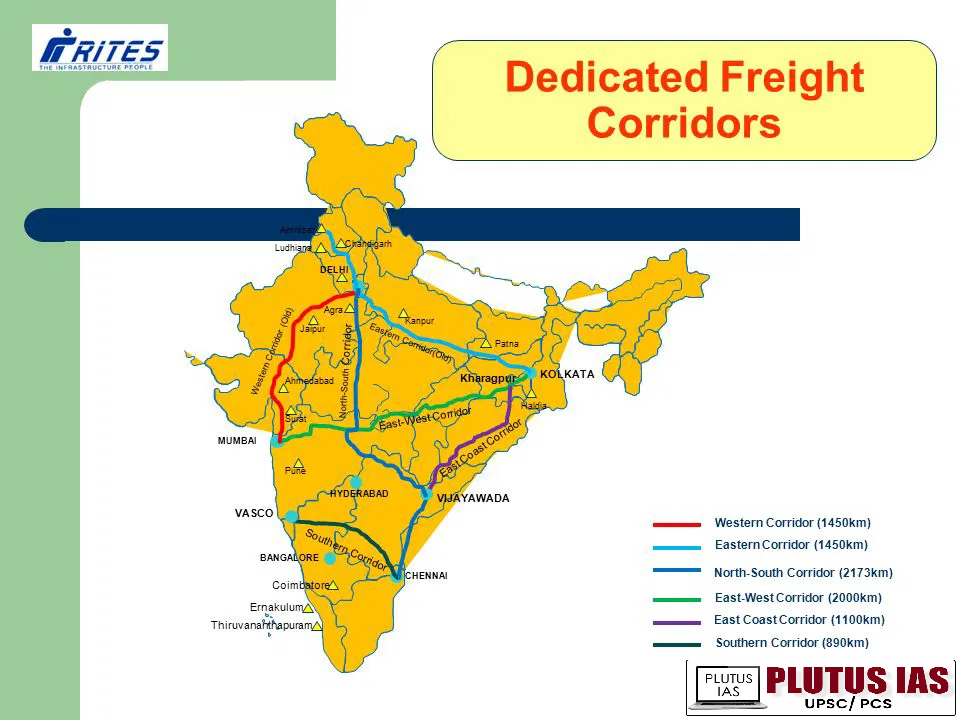06 Nov “Dedicated Freight Corridors: A Key Driver of GDP Growth and Economic Development”
SYLLABUS MAPPING:
GS-3- Economics-“Dedicated Freight Corridors: A Key Driver of GDP Growth and Economic Development”
FOR PRELIMS:
What are Dedicated Freight Corridors (DFCs), and how do they differ from traditional rail corridors?
FOR MAINS:
Evaluate the challenges associated with the implementation of Dedicated Freight Corridors in emerging economies. What measures should be taken to overcome these challenges?
What are Dedicated Freight Corridors (DFCs)?
1. It is a high-speed & high-capacity railway corridor that is exclusively meant for the transportation of freight (goods & commodities).
2. On the normal lanes, goods trains must make way for passenger trains, thereby delaying freight movement.
3. The surging power needs requiring heavy coal movement, booming infrastructure construction, & growing international trade have led to the conception of Dedicated Freight Corridors.
4. DFC involves the seamless integration of better infrastructure & state of the art technology.
5. It will allow for efficient & fast movement of freight (very important for the horticulture sector)
Dedicated Freight Corridor Project
Under Ministry of Railways:
The project involves the construction of six freight corridors traversing the entire country.
The purpose of the project is to provide a safe & efficient freight transportation system.
Initially, the construction of two freight corridors,
1. Western DFC connecting the states of Haryana & Maharashtra &
2. Eastern DFC, connecting the states of Punjab & West Bengal, is being undertaken.
The other four corridors include
1. North-South (Delhi-Tamil Nadu),
2. East-West (West Bengal-Maharashtra),
3. East-South (West Bengal-Andhra Pradesh) &
4. South-South (Tamil Nadu-Goa).
These four corridors are still in the planning stage.
In 2006, the Government of India established a dedicated body to implement the project, called the Dedicated Freight Corridor Corporation of India (DFCCIL).


Significance:
The diversion of freight to DFCs on trunk routes will free up the existing network for the kind of capacity expansion needed for passenger movement.
It will also integrate the Industrial Corridors.
Western Dedicated Freight Corridor (WDFC):
1. Dadri, U.P to Jawaharlal Nehru Port, Mumbai-1,468 km
2. The WDFC covers Haryana, Rajasthan, Gujarat, Maharashtra & Uttar Pradesh.
3. It is being funded by the Japan International Cooperation Agency.
Eastern Dedicated Freight Corridor (EDFC):
1. Ludhiana Punjab to Dankuni West Bengal-1,760 km
2. The EDFC route covers Punjab, Haryana, Uttar Pradesh, Bihar, Jharkhand & West Bengal.
3. The EDFC route has coal mines, thermal power plants & industrial cities.
4. Feeder routes are also being made for these.
5. EDFC is being funded by the World Bank.
6. The Connecting Link for the Eastern & Western Arm is under construction between Dadri & Khurja.
Contribution of Dedicated Freight Corridors (DFCs) to GDP Growth:
2. Increased Industrial Productivity: By improving the speed and reliability of freight movement, DFCs enable industries—especially manufacturing, agriculture, and mining—to lower supply chain disruptions and increase output, contributing to higher economic productivity.
3. Boost to Exports and Trade: DFCs improve connectivity to ports, speeding up exports and making goods more competitive globally. Enhanced trade efficiency directly contributes to GDP growth through higher export revenues and improved trade balances.
4. Job Creation and Regional Development: The construction and operation of DFCs create jobs, both directly in logistics and indirectly in supporting sectors. DFCs also stimulate economic development in underdeveloped regions, reducing regional disparities.
5. Improved Infrastructure and Connectivity: DFCs enhance national infrastructure and foster multi-modal transport (rail, road, port). This connectivity reduces transport bottlenecks, increases supply chain efficiency, and drives industrial growth.
6. Environmental Benefits: By reducing reliance on road transport, DFCs lower carbon emissions, promoting sustainability. This long-term environmental benefit supports a more resilient economy.
7. Consumer Benefits: Lower logistics costs typically result in reduced product prices, boosting domestic consumption and, in turn, driving demand and economic growth.
8. Technological Innovation: The development of DFCs often incorporates cutting-edge technologies, enhancing efficiency and encouraging innovation across other sectors, further spurring economic growth.
Issue still persists:
1. Infrastructure Delays: Slow construction due to land acquisition issues, regulatory hurdles, and funding shortages.
2. High Costs: DFCs require significant investment, and financial constraints or reliance on public funds can delay projects.
3. Land and Environmental Concerns: Challenges in securing land and potential environmental impacts, causing delays and resistance.
4. Regional Disparities: Benefits are concentrated in major industrial hubs, exacerbating regional inequalities.
5. Operational Challenges: Difficulty in integrating advanced technologies and potential inefficiencies in operations or maintenance.
6. Social Impact: Job displacement in traditional sectors like road transport and potential resettlement issues for displaced communities.
7. Policy Gaps: Lack of coordinated planning and regulatory delays hinder smooth project execution.
8. Sustainability Issues: Long payback periods and reliance on freight revenues make long-term economic sustainability challenging.
Way Forward:
1. Speed Up Construction: Streamline land acquisition and simplify regulatory approvals. Leverage PPPs to reduce delays and share risks.
2. Ensure Financial Sustainability: Use diverse funding options (green bonds, private investment) and conduct thorough feasibility studies to ensure long-term viability.
3. Enhance Multi-modal Connectivity: Integrate DFCs with roads, ports, and airports to create seamless logistics networks and develop logistics hubs along corridors.
4. Adopt Technology: Implement IoT, AI, and automation for efficient operations, real-time tracking, and predictive maintenance.
5. Promote Regional Development: Focus on linking underdeveloped areas to industrial hubs and use incentives to drive investment in these regions.
6. Reduce Social & Environmental Impact: Implement sustainable technologies (e.g., electric trains) and create comprehensive resettlement packages for displaced communities.
7. Maximize Employment: Focus on job creation in logistics, tech, and infrastructure sectors, with skill development programs to meet workforce needs.
8. Policy Coordination: Align DFCs with national infrastructure goals and create a long-term vision (20-30 years) for integrated growth.
Conclusion:
Dedicated Freight Corridors (DFCs) are a transformative initiative that can significantly enhance the efficiency of freight transportation, boost industrial productivity, reduce logistics costs, and contribute to GDP growth. While the project faces challenges such as infrastructure delays, financial constraints, and social impacts, the way forward lies in streamlined construction, leveraging advanced technologies, ensuring financial sustainability, and promoting regional development. By addressing these hurdles, DFCs can become a key driver of economic growth, improving competitiveness, creating jobs, and enhancing sustainability for long-term prosperity.
Download plutus ias current affairs (Eng) 6th Nov 2024
Prelims Question:
Q. Which of the following corridors is part of the Western Dedicated Freight Corridor (WDFC)?
A. Ludhiana to Dankuni
B. Dadri to Jawaharlal Nehru Port
C. Delhi to Tamil Nadu
D. West Bengal to Andhra Pradesh
Answer: B
Mains Question:
Q. Critically assess how the implementation of Dedicated Freight Corridors aligns with India’s overall infrastructural development goals, including those outlined in the National Infrastructure Pipeline (NIP) and the National Logistics Policy (NLP).
(250 words, 15 marks)



No Comments